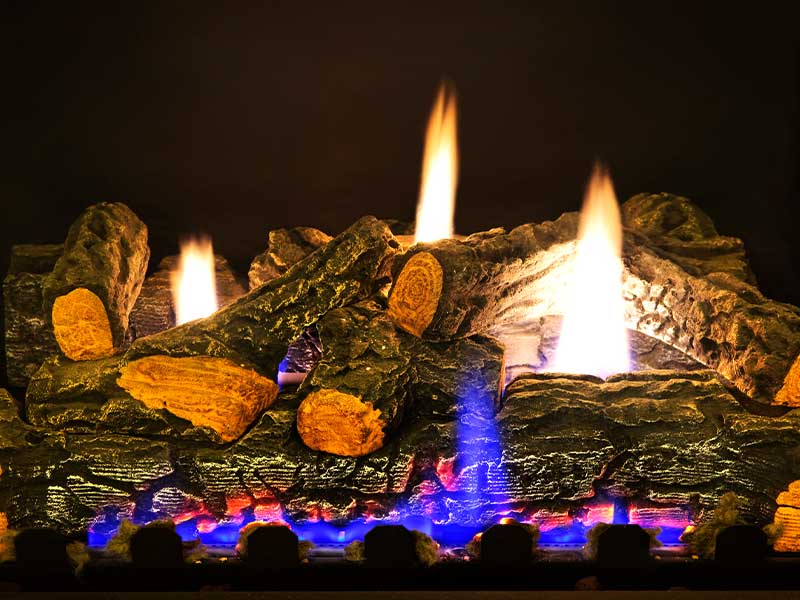
by blogediter | Jul 8, 2019 | Gas Logs
Q: I have an old house and for whatever reason, there is not a damper at all (never was) on the fireplace. I love vent-free logs and am planning on installing them in this fireplace. Do you make a product that I can use in lieu of having to have a damper installed in order to keep the heat from my vent free logs in the house? _ ET
A: ET, I’m sorry we do not have a heat-resistant version of the Chimney Balloon. Our product is actually designed to release if exposed to acute heat. I wish I could direct you to this issue, but your fireplace and mantel may not be well equipped to handle the heat spillage from a vent-less gas log. I wouldn’t want you to risk a fire from having heat spilling up across your lintel and mantel. You may want to think carefully if this is in fact how you would like to heat that room. – Jason
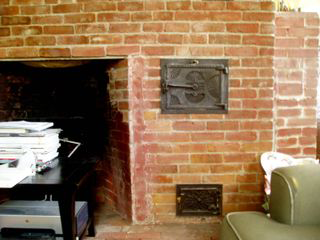
by blogediter | Mar 18, 2019 | Fireplaces
Q: Jason, One of the fireplaces in our 1844 house has an oven built into the fireplace hearth face, which we’ve never used. The oven has a door, and there is a clean-out door below the oven door. Can you make a guess if the Chimney Balloon would seal off the oven as well as the fireplace in one shot? Thanks, MB
A: Dear MB, A picture is worth a thousand words. Thank you for that photo of the hearth fireplace oven.
Sealing both with one Chimney Balloon is not recommended since you don’t know how high up the connection may be in the flue. I would sell them individually.
On the fireplace…I would measure the area where the fiberglass is at (I can see the yellow sticking down just below the lintel). I understand that is a trapezoid shape, so you will need a measurement of the front, the back, and the depth of that flue opening.
If this main fireplace flue has a fireplace damper you will also want a measurement above the damper since that may be a better location to install a Chimney Balloon if the damper hardware is in the way in the lintel area. Sealing the large flue is the main issue and that will stop most of the air infiltration, so let’s do that first.
If you still have the draft coming through the hearth oven then we can do a separate Chimney Balloon for that inlet. My suggestion for the oven would be to measure the shoot that runs out of the top or side of the oven enclosure. It should be a smallish rectangle or square vent heading up like a chimney.
With those measurements, we can get this fireplace air sealed, so the cold draft is not an issue anymore. – Jason
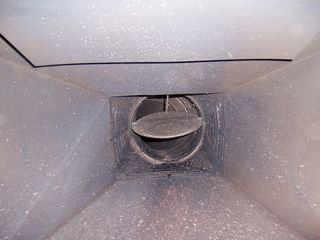
by blogediter | Apr 30, 2018 | Chimney Plugs
Flue Walls Slant
Q: Inside my fireplace, about 29″ up from above the opening is the damper. Just below the damper and each of the four sides or slit type openings. I do not know why. Maybe for air? I just saw the picture from SH and that is what mine likes like except all 4 sides slant in. It is about 10×10 at the damper. – KT
A: Dear KT, Since the sides slant on all 4 sides we will have to do the install high or low. We can use a HEK extender and a small 12×12 Chimney Balloon to install above the damper, or we can use the ledge that is generally just on the lintel and install a larger 36×15 Chimney Balloon. The lower install is easier but the balloon may be slightly visible from the room. _ Jason
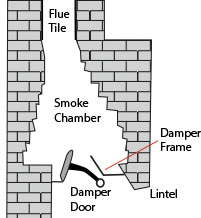
by blogediter | Aug 23, 2017 | Fireplaces
So you want to know the names of the parts of a fireplace and chimney?
Just so we have our chimney terminology straight, here is a labeled diagram of the parts of a fireplace and chimney.
This is a list of the names of the parts of a fireplace and chimney:
Ash Chute: A hole in the floor of the firebox that you can sweep ash and burnt debris into. It is often connected to a pocket area below the firebox of in the basement that has an small metal exterior door for removal of fireplace ash.
Crown: The crown of the chimney is the flat surface at the top of the chimney structure. This is also the platform on which the chimney cap sits.
Damper Door: This is a metal door that pivots and open and closes. Sometimes it has a hinge and sometimes it is just a metal flap setting in place by gravity. They can be cast iron or sheet metal. Homeowners often call the damper the “flue” or “flume” but in fact the flue is the hole that the damper is closing off.
Damper Frame: This is the metal frame that is mortared in place and is immovable. The damper door connects against this frame. The frame can be sheet metal or cast iron.
Firebox: This is the open mouth area of the hearth that you put the logs and have the fire.
Flue Tile: This is the area of the chimney where the walls are parallel and the chimney makes a long run to the chimney top. It is often lined with a clay flue tile, or a metal flue liner. Sometimes it is just bare brick.
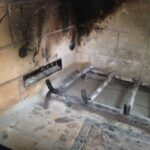
fresh air intake part of a fireplace
Fresh Air Inlet: This is not shown on our diagram, but the left image is a photo of one. This is a vent on the side or back wall of the firebox that vents through the wall to the outside. Fresh air intakes are designed to give the firebox plenty of outside combustion air while you have a fire burning.
Lintel: This is the top lip of the fireplace hearth opening. If you are setting a log in the firebox and you hit your head on the bricks above your head… that is the lintel.




